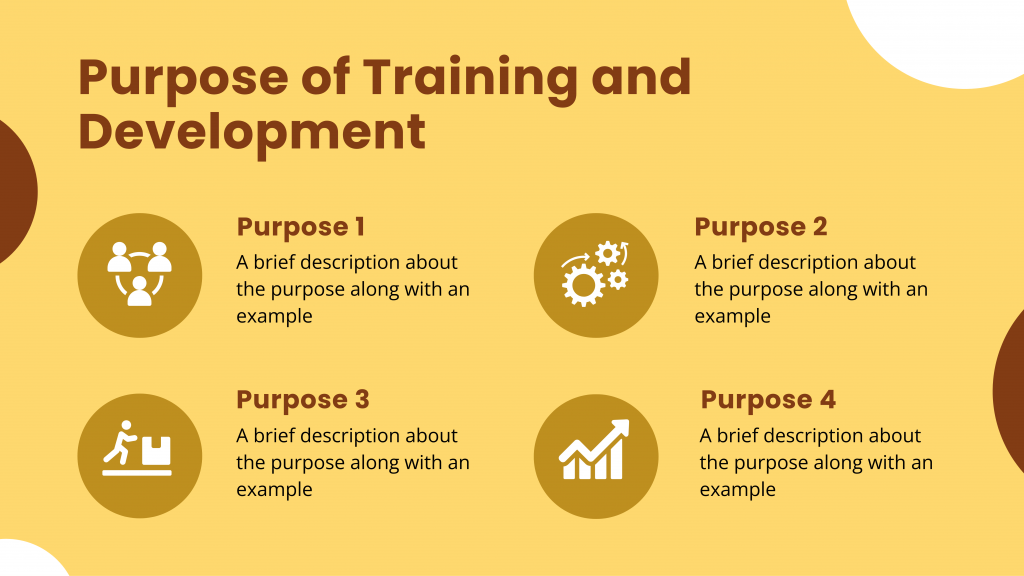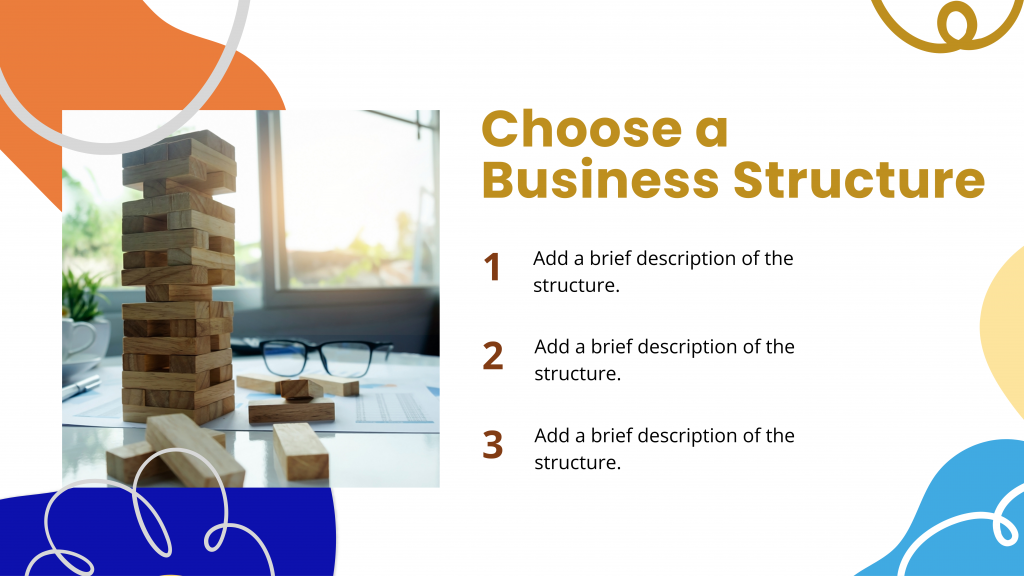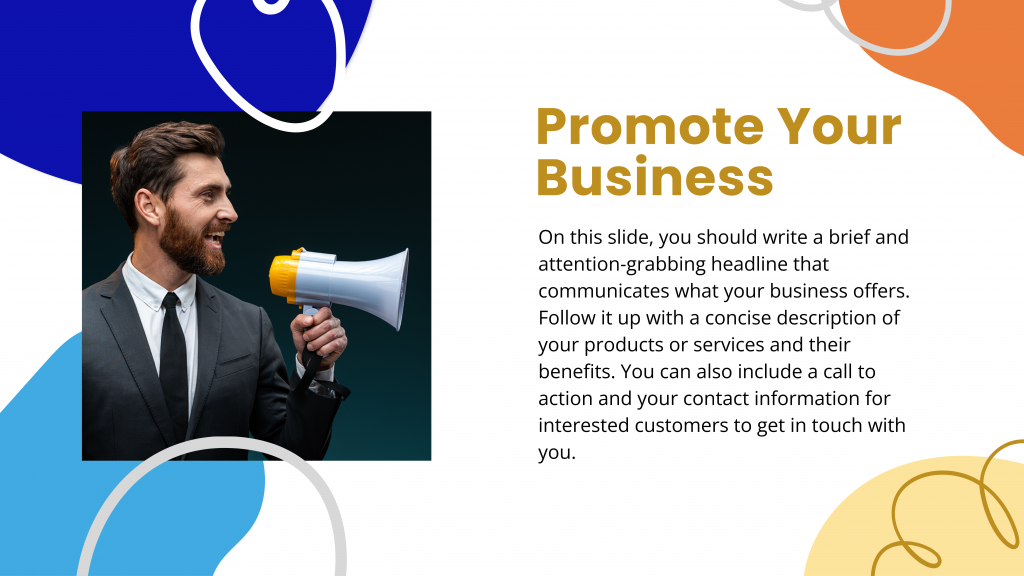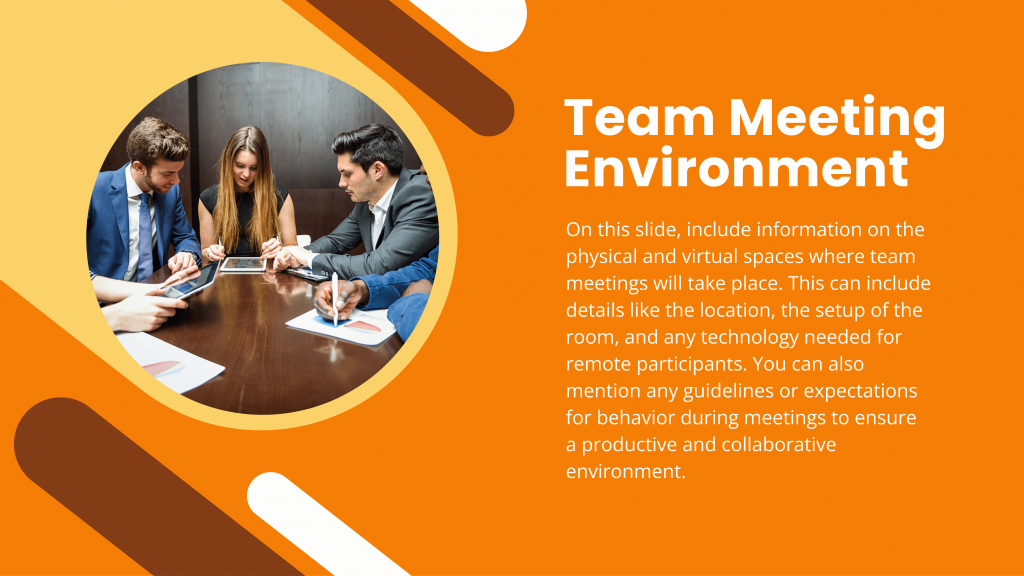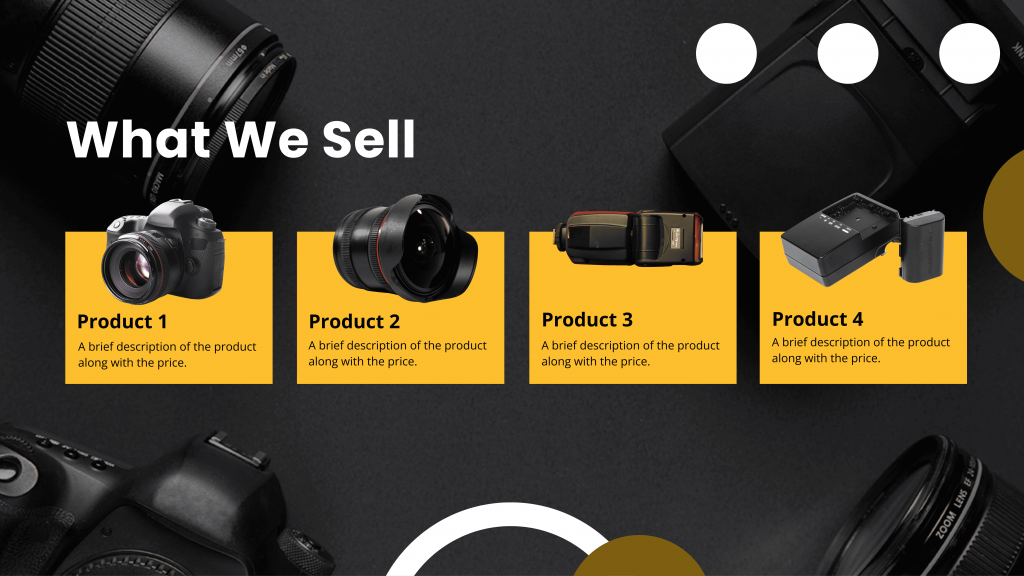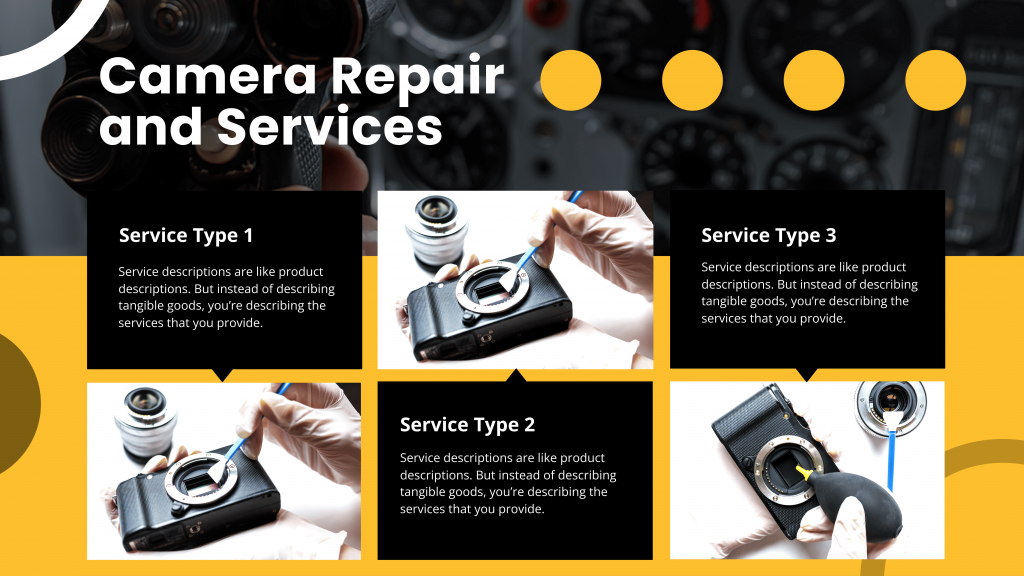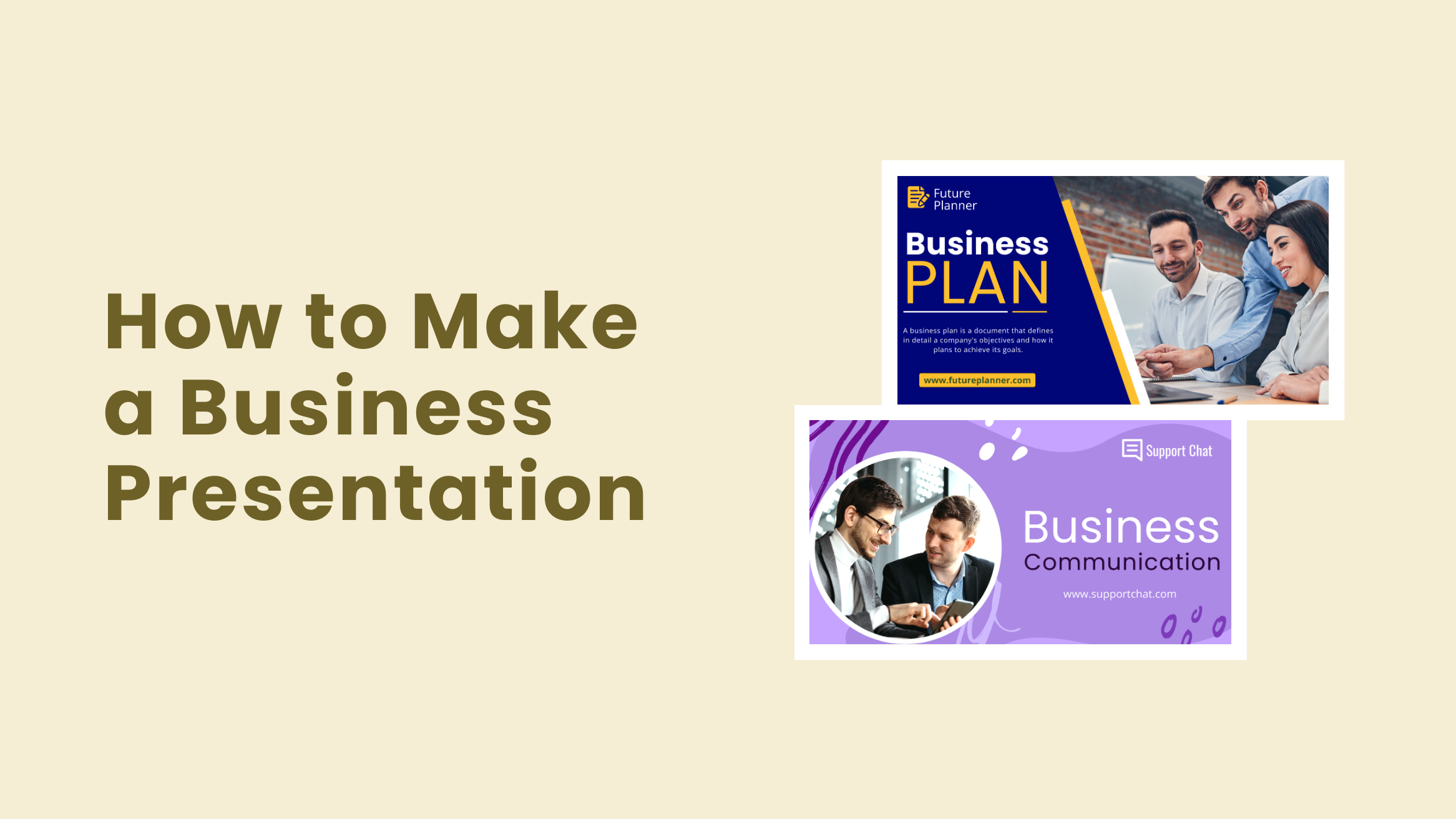
How to Make a Business Presentation: A Complete Guide

Have you ever wondered how to make a business presentation that wows your audience? You’re not alone! There’s no lie that every marketer finds crafting compelling presentations is a major hurdle. That’s why 77% of marketers agree they use AI tools to craft more effective and tailored content for their audiences.
How to Make a Business Presentation
- Write Objective: Clearly define the purpose (inform, persuade, educate).
- Understand Target Audience: Understand their needs and expectations.
- Research and Gather Information: Collect data, statistics, and examples.
- Anticipate Questions: Prepare for potential audience queries.
- Craft a Clear Outline: Organize content logically into slides.
- Short Slide Copies: Keep the text brief and to the point.
- Cohesive Design Style: Maintain a consistent, professional look throughout the presentation.
In this guide, we’ll cover essential tips for creating impactful business presentations, from structuring your message to designing eye-catching slides, everything step-by-step. Moreover, with DocHipo and its advanced AI capabilities, you’ll discover how easy and efficient presentation design can be!
Table of Contents
- Why Are Business Presentations Important
- What Makes an Effective Business Presentation
- What to Include in a Business Presentation
- How Do You Plan a Business Presentation
- How to Write a Business Presentation
- How to Make a Business Presentation Design
- Delivering Your Business Presentation with Confidence and Impact
- How to Make a Business Presentation Interactive
- How to Make a Business Presentation with DocHipo
- FAQ
Why Are Business Presentations Important
If you want to dive deep into it, you might ask yourself, “What is the objective of a business presentation?” The primary objective of a business presentation is to convey valuable information in a persuasive and impactful way, often helping you secure buy-in or drive action.
Business presentations are essential because they allow you to communicate your ideas, products, or services directly to your target audience, making them feel involved and informed.
For instance, if you pitch a new product to potential investors, a well-structured presentation can highlight its benefits, market potential, and financial forecasts.
Now, let’s understand, “What are the two common purposes of business presentation?” The two common purposes of business presentations are to educate and persuade – whether training a team on new processes or convincing clients that your solution answers their problem. A good presentation can be the key to successful communication and achieving your business goals!
What Makes an Effective Business Presentation
What should a business presentation look like to make an impact? An excellent business presentation should be visually clean and professional, provided with a consistent business presentation layout theme.
Here is a good example of a business presentation from DocHipo.

Get This Template and More
Everybody wants to make good business presentations, but some common issues can ruin them if you don’t pay proper attention. Here are some of the most common problems that you should be aware of while making a business presentation:
1. Attention Span and First Impressions
Suppose you have just three seconds to grab your audience’s attention. Research shows that those first moments can make or break their impression of you and your message. Start with an intriguing story or eye-catching visuals, and you’ll instantly boost engagement and keep them hooked throughout your presentation.
2. Structure and Clarity
An organized presentation keeps your audience on track. By following a clear structure—such as an engaging opening, a defined agenda, and a memorable closing—you’re more likely to keep their interest. Presentations with a logical flow are 70% more likely to drive a sale, proving that a structured approach is key to persuasion.
3. Emotional Engagement
Building an emotional connection is crucial. Presentations that resonate on a personal level with their audience have higher success rates. Studies suggest that up to 90% of sales come from presentations that tap into emotions, which helps you leave a lasting impression and reach your goals.
You must be mindful of a few things to avoid these pitfalls and make an effective presentation. To create an effective business presentation, focus on your audience’s needs and aspirations. Think about what matters most to them, and tailor your message accordingly.
You aim to show them exactly how your product or service can solve their specific challenges or help them reach their objectives. Keep your content concise, relatable, and benefit-focused so that every slide speaks directly to what your audience cares about. Remember, the more your presentation aligns with their goals, the more impactful and memorable it will be!
What to Include in a Business Presentation
Are you wondering what a good business presentation is? It has three main aspects: an introduction, a main body that captures the essence of the problems and solutions, and conclusions.
If you’re an HR professional providing training to your employees, the main body of the presentation should look like the following.
As for “what should be in a business presentation,” you must include a captivating title with the brand name and theme, an introduction slide with pointers, clear objectives, data-backed insights to support your claims, and actionable takeaways in the form of recommendations.
Don’t forget to wrap it up with a strong call to action that drives home your message and encourages the next steps!
A well-organized presentation typically follows this format:
| Section | Purpose |
| Introduction | Set the stage; introduce the topic and objectives |
| Main Body | Present key points with supporting evidence |
| Conclusion | Summarize key messages; call to action |
By incorporating these elements into your business presentation, you can create a compelling narrative that effectively communicates your message and engages your audience, like the one below.

Get This Template and More
How Do You Plan a Business Presentation
Planning a business presentation can seem daunting, but a clear approach will set you up for success. Start by understanding how to start a business presentation effectively. I have laid out the impeccable and essential five steps to plan and structure your creative presentation to make it impactful!
1. Set the Objective of the Business Presentation
Begin by identifying the main goal. Are you trying to inform, persuade, or educate? Clarifying your purpose will help shape your message and keep the presentation focused. I suggest writing down your objective in a single sentence and keeping it visible as you prepare—this will keep you aligned and on track.
3. Understand Your Target Audience and Their Needs
Who will be in the room? Make your business presentation aligned with their interests, challenges, and preferences. The more you know about your audience, the better you can craft a message that resonates. Picture yourself in their shoes, and think about what they hope to gain. Connecting on this level makes your presentation effective, more engaging, and relatable.
4. Research and Gather Information about the Problem
Dive into the topic thoroughly so you can address it with authority. Collect data, statistics from case studies, and real-world examples to support your points. If discussing how your product solves a problem, be prepared with solid evidence. This adds credibility and keeps your audience engaged with valuable insights.
5. Anticipate Questions of Your Audience to Impress Them
Think about potential questions and doubts they might have. Preparing responses ahead of time not only shows you’re knowledgeable but also boosts your confidence. Addressing these proactively can be a powerful way to establish trust. Remember, being ready for their questions shows you truly understand their concerns.
6. Craft a Clear Outline to Create Slides
Organize your presentation into an outline with a logical flow. Start with an introduction that grabs attention, move into the body with key points, and end with a compelling conclusion.
This outline will be the foundation for writing your slides, ensuring your message is delivered clearly.
With these steps, you’re on your way to creating a business presentation that’s not only well-organized but also impactful and memorable!
How to Write a Business Presentation
After all the planning, writing a great business presentation might sound scary, but breaking it down into clear sections can make it much simpler – and more effective. Here’s how to create a business presentation of a company that flows naturally and leaves a lasting impression:
1. Title Slide That Reflects Your Goal
Your title slide is like the front cover of a book – it sets the tone for everything that follows. Make sure it’s professional, visually appealing, and hints at your objective. For instance, if your goal is to pitch a new product, include the product name and a tagline that captures its main benefit, like the one below.

Get This Template and More
2. Compelling Introduction for the Context
Jump right into the heart of why you’re there. Start with a question, a quick story, or a surprising fact. This sets the context and grabs your audience’s attention immediately. For example, you can write an overview of your company or the product with a background story!
The following introduction slide is one of the best business presentation templates because it provides a brief explanation of how to write an introduction.

Get This Template and More
3. Present a Roadmap or Table of Contents
Lay out what the audience can expect. A roadmap or table of contents gives your presentation structure and prepares your audience for what’s to come. You can keep it simple – just a few bullet points on the main topics you’ll cover, like “Problem, Solution, Results, Next Steps.”
4. Problem Statement
Now, it’s time to outline the problem you’re addressing. Be clear and concise, using real-world data or a relatable scenario. The key is to get your audience to understand why this issue matters. Let’s say you’re presenting a cutting-edge AI tool that can help small businesses with cost-effective solutions, and the problem your audience is dealing with is the constant rise of start-up failures. Then, you can use business presentation slide templates like the following ones.

Get This Template and More

Get This Template and More
5. Main Body: Key Points, Supporting Evidence, and Clear Messaging
In the main body, dive into the details. Present your key points, back them up with data, and use visuals to reinforce your message. Try organizing your content logically and including supporting evidence or case studies to demonstrate credibility. Each slide should answer a question, resolve a point, or support the next.
6. Solution or Strategy
Here’s where you show them the answer. Explain how your solution addresses the problem and outline the steps involved. Describe how it works and its benefits, whether a product, service, or strategy. Make it specific—audiences want details that paint how this solution can make their lives easier.
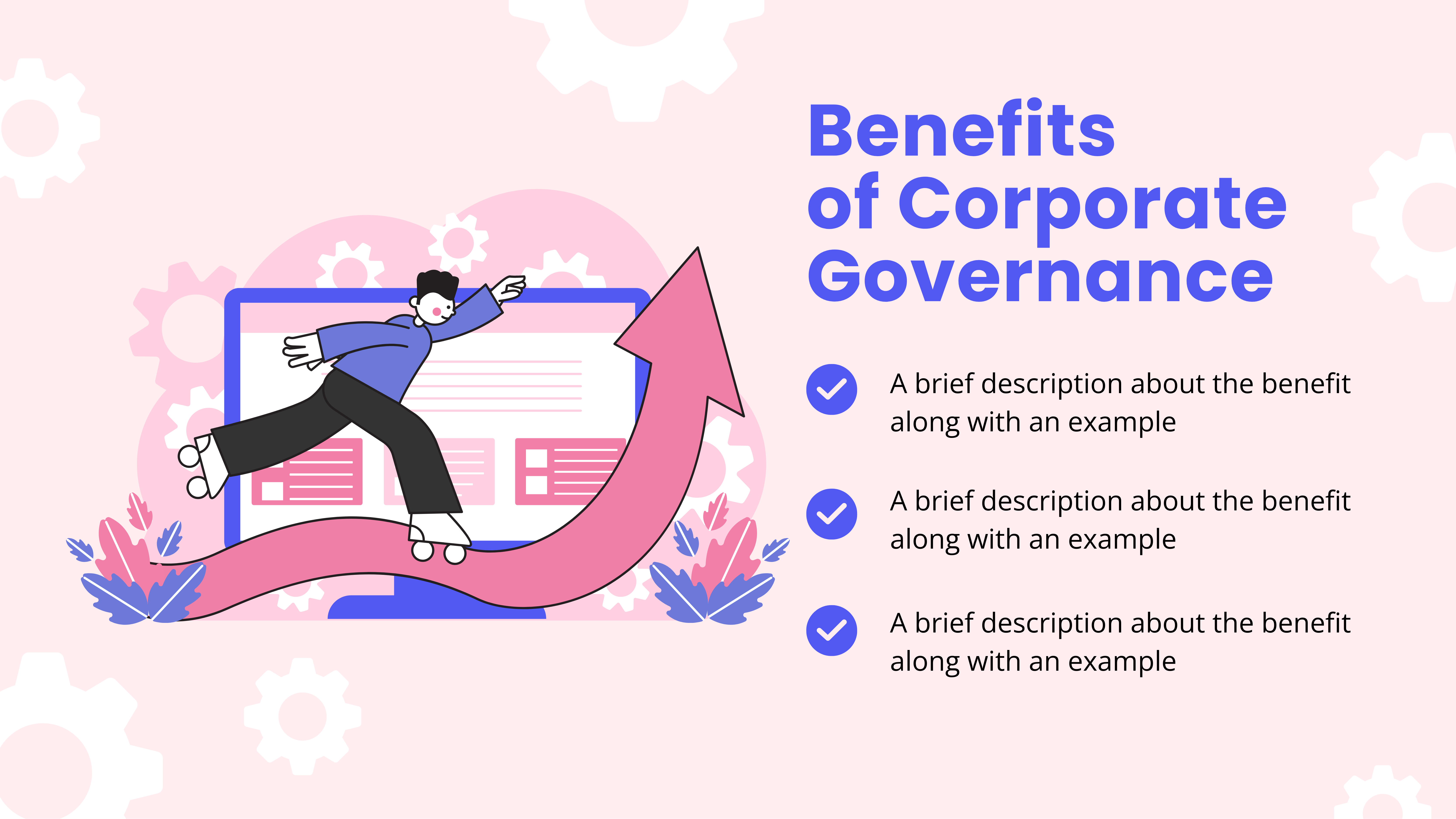
Get This Template and More
7. Storytelling with Minimal Text, Data, and Examples
Make your points memorable by weaving in storytelling. Keep text minimal and focus on visuals – charts, graphs, or photos—to highlight key information. Tell a quick success story of a client or business that has already benefited from this approach. Real-life examples stick with people, so aim to bring your points to life.
Check out the business presentation templates, which show how to leverage attractive visuals and minimal text.
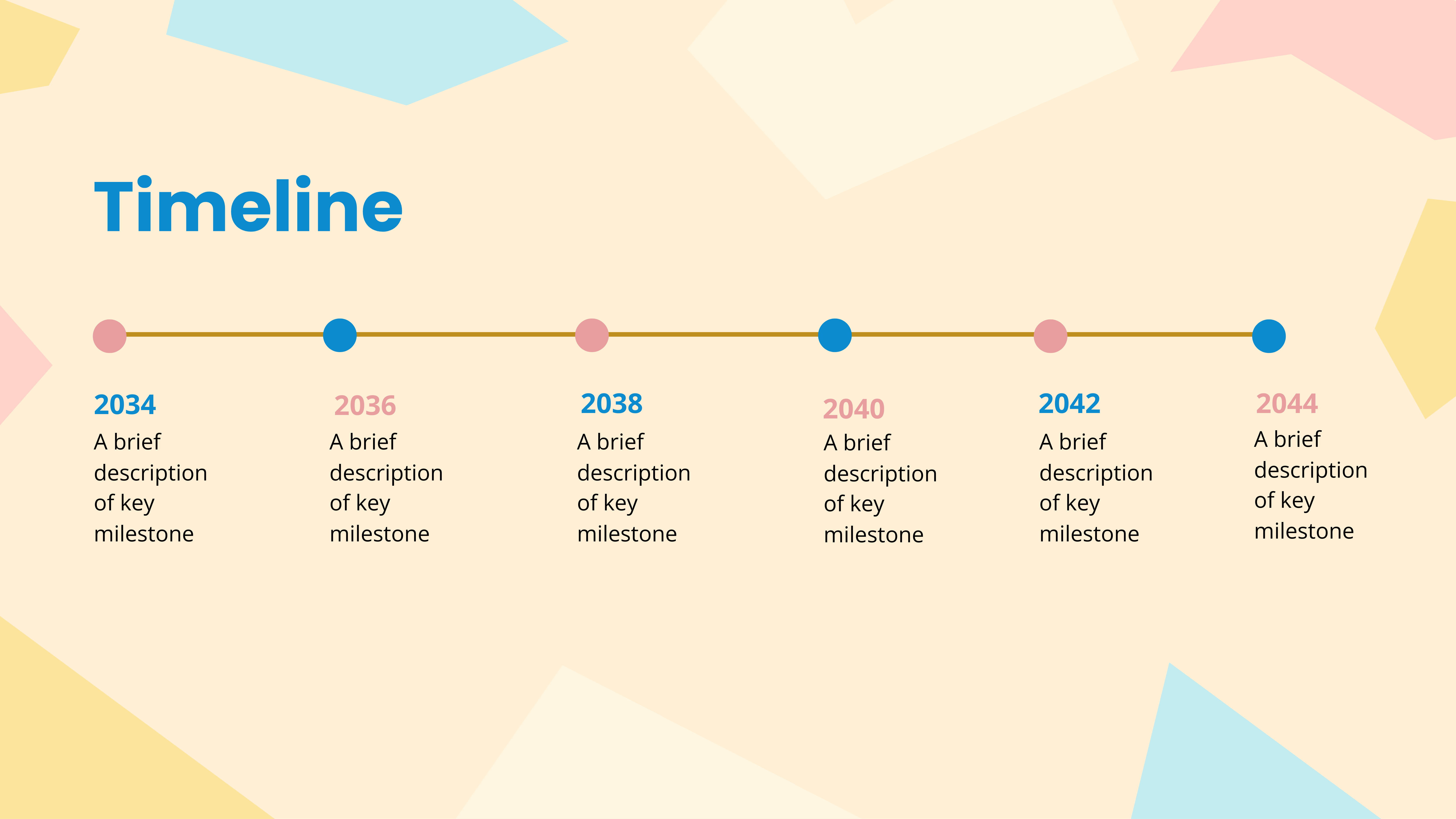
Get This Template and More

Get This Template and More
8. Ending the Presentation: Call to Action and Conclusion
Wrap up with a powerful conclusion and a clear call to action. Do you want your audience to schedule a follow-up meeting, approve a project, or simply contact your team for an inquiry? Let them know exactly what to do next.

Get This Template and More
9. Acknowledgments and References
Lastly, show appreciation for any team members, partners, or online resources that contributed to your presentation. Briefly acknowledge them at the end, and include any references for the data you presented. This final touch adds professionalism and credibility to your work.
Following these steps will help you craft a clear and persuasive business presentation that will set you apart from other pitches.
How to Make a Business Presentation Design
Designing a business presentation that stands out requires a thoughtful approach, and with the right strategies, you can ensure it captures attention from start to finish. Here’s how to create a presentation that’s polished, professional, and engaging:
1. Choose a Consistent Business-appropriate Design Theme
Let’s take you to a typical moment in a marketer’s life! You’re sitting in a room, and a presenter clicks through slides that look like a colorful explosion on one and a grayscale boardroom on the next. Distracting, right? Only a consistent design theme can help you in this case. Stick to a professional color palette and select fonts that match your brand’s vibe—whether that’s sleek and modern or bold and traditional. A cohesive look shows you mean business!
Check out the business presentation template that reflects a power-packed brand consistency so that the audience can remember your brand for a long time.
You can easily achieve this look with your own brand colors and assets in a single click with DocHipo’s brand kits.
Watch the video to try brand kit features in DocHipo for seamless on-brand presentations in a jiffy.
2. Highlight the Key Information
Think of your slides as a quick roadmap for your audience. Highlight the essential points, but don’t overload with text. Use sophisticated color combinations and short, simple texts for the main takeaways so your message is clear at a glance. Imagine your audience quickly scanning each slide—they should be able to catch the most critical information instantly.
Check out the business presentation slides to get an idea of how to make a business presentation design professionally.
3. Incorporate Visuals Strategically
A great image, branded illustrations, or colorful chart visualizations can say a thousand words, but make sure every visual adds value.
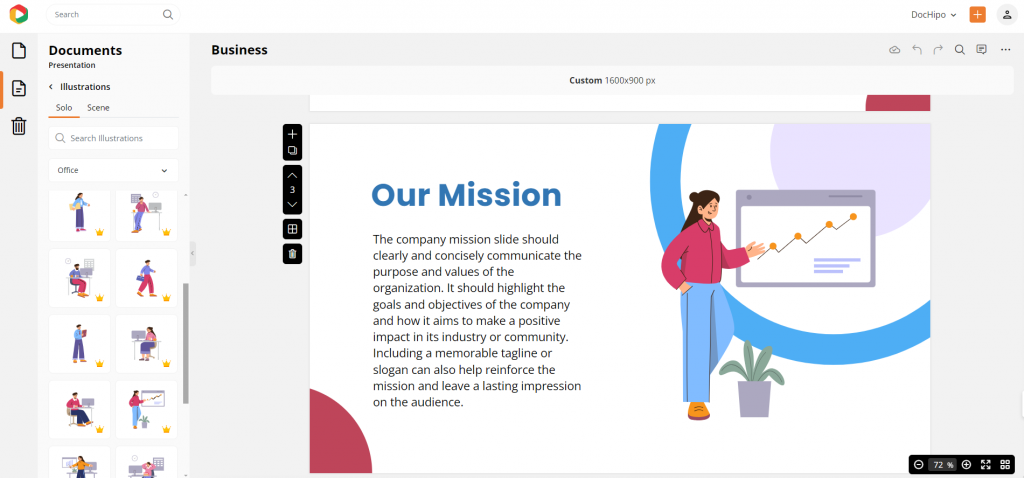
For example, a well-designed graph can simplify complex stats if you’re presenting sales data. Use high-quality stock images and icons that complement your message without overwhelming it. Visuals like interactive maps keep your audience engaged and help them remember the content better.

Get This Template and More
Also, DocHipo’s potent AI text-to-image generation can take your business presentation slides to the next level. With any descriptive prompts and a ton of styles of images, such as realistic, 3D, oil painting, cinematic, anime, illustrations, logos, and more, you can create your title slide images, online logos, or meaningful charts that can reduce the words in your presentation yet make it more comprehensive.
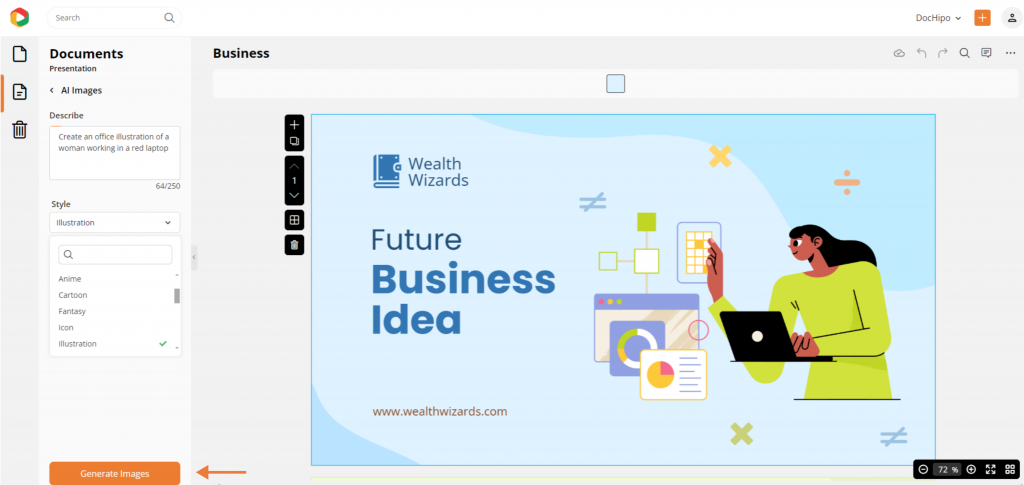
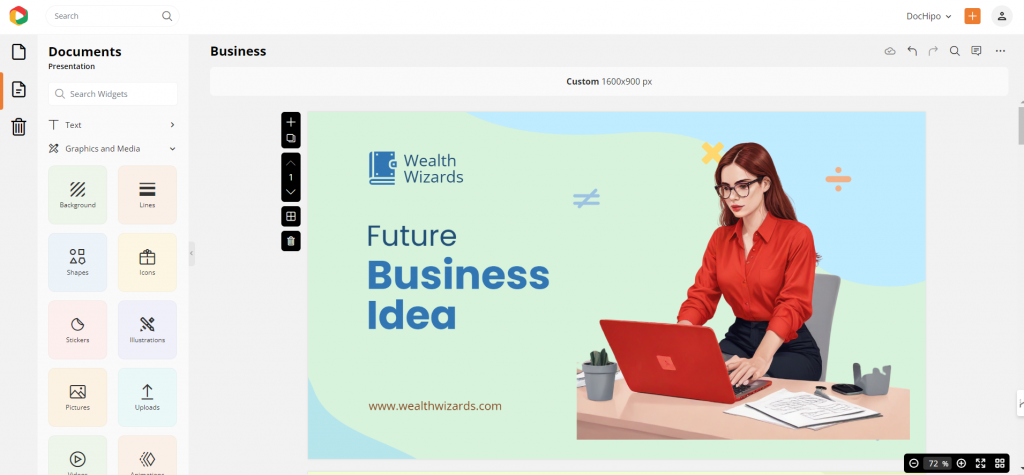
Check out the video to make AI images with DocHipo.
4. Strategic Font Size, Text and Background Contrast for Readability
Make readability a priority by choosing a font size that can be easily read from the back of the room (or on a small screen if it’s virtual). High contrast between text and background—like dark text on a light background or vice versa – helps ensure your content is clear and accessible. Nothing’s worse than having your audience squinting to make out the words!
Try the following business presentation template to make your message and visuals more visible. It features a professional font style, adequate size, and stark font colors, creating a clear contrast against the chic background!

Get This Template and More
5. Keep the Slides Simple, Organized, and Uncluttered
To understand why you should maintain white space in design to allow detailed attention, you need to first ask the obvious question: What is the primary purpose of a business presentation?
The primary purpose of a business presentation is to clearly and persuasively communicate key information to your audience, whether it’s to inform, persuade, or motivate some action. That’s why a simple and uncluttered design enhances this purpose by allowing your message to stand out without distractions, making it easier for your audience to understand and retain the information.
In business settings, where first impressions and clarity are crucial, a clean, well-organized presentation demonstrates credibility and respect for your audience’s time, ultimately helping you achieve your goals more effectively.
Remember, you want your audience to listen to you—not read through a novel on each slide!
By following these basic design principles, you’ll create a business presentation design that’s visually appealing and effective in delivering your message.
Delivering Your Business Presentation with Confidence and Impact
Delivering a business presentation with confidence and impact comes down to preparation, practice, and engagement. First, know your goal and content inside and out. When you feel comfortable with your content, you’ll naturally feel more confident. Then, practice! Go through your presentation multiple times, ideally in front of a mirror or with a friend, to help you get comfortable with the flow.
Use your voice effectively—try varying your tone, speed, and volume to keep the audience’s attention. Remember to make eye contact to connect with them, and don’t be afraid to pause after key points; it shows poise and allows your message to sink in. By staying relaxed and authentic, you’ll create a positive impression.
How to Make a Business Presentation Interactive
I can understand that you feel like juggling with too many things in your mind. Keeping your audience engaged is a daunting task. Wondering, “How do I make my business presentation more engaging?” So, ask open-ended questions to invite participation, like, “What challenges have you faced in this area?” or “How would you tackle this problem?”
These questions encourage people to share, making your presentation feel more like a conversation. Incorporate quick polls or real-time feedback tools—the audience loves seeing their input reflected in the presentation! You could also try adding interactive visuals, like clickable charts or videos, that allow the audience to explore on their own.
These simple, interactive elements make your presentation more dynamic and enjoyable so your audience stays actively involved and invested in what you’re sharing.
How to Make a Business Presentation with DocHipo
Now that you’re familiar with all the business presentation tips and tricks, it’s time to put them into action! With DocHipo’s business presentation templates, you can create a stunning presentation in minutes—even if you’re a beginner. Thinking about how to start a business presentation? Sign up, explore different types of business presentation templates, and build your own presentation in just three easy steps!
1. Select a Business Presentation Template
Once you’ve signed up and reached DocHipo’s homepage, search for presentation templates. The templates are easy to find and ready to help you get started with your business presentation design in no time!
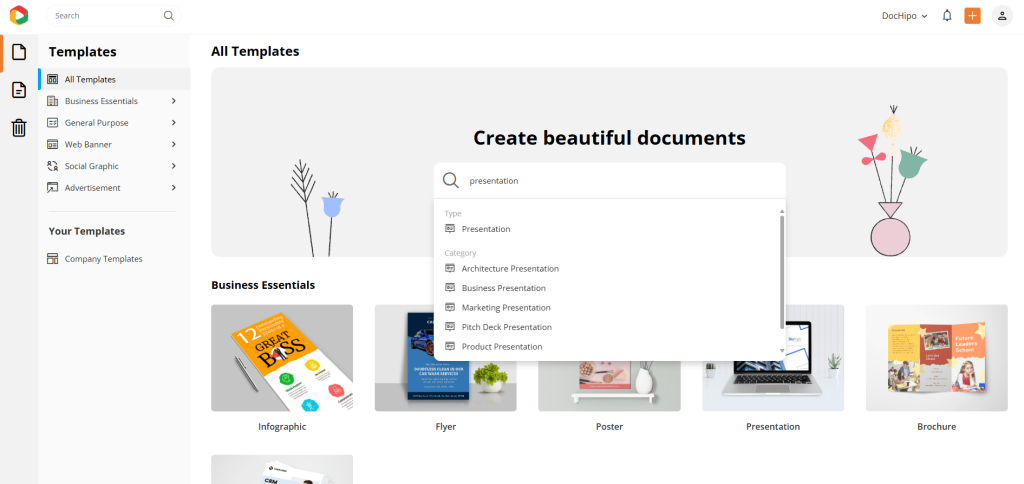
Watch this video and learn to find any template within seconds.
You’ll find a variety of template categories available in the DocHipo presentation library. Select the “Business” category to browse through a collection of business templates.
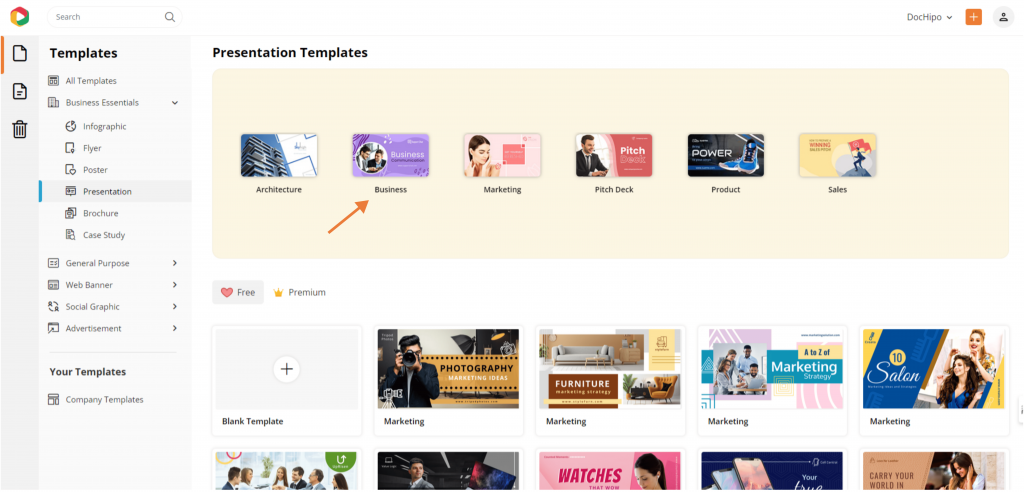
You’ll find business presentation templates tailored to different industries and use cases. Simply pick a design that suits your needs and start personalizing it!
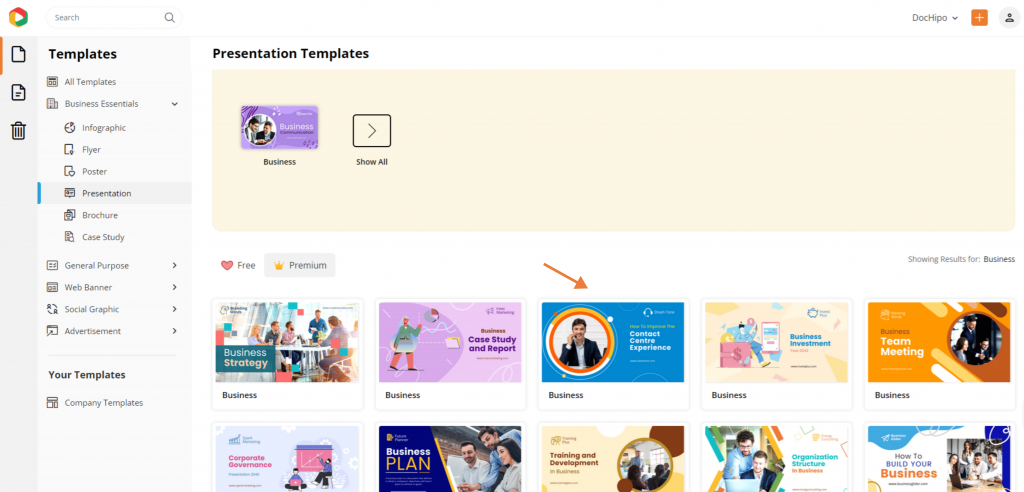
2. Personalize Your Template with Business Related Design Assets
In the DocHipo editor, you have full control to personalize your slides using myriads of trendy design widgets, including icons, stickers, illustrations, animations, stock photos, shapes, fonts, and backgrounds. You can easily tweak the text, visuals, and other design elements to match your brand’s look and feel, creating a business presentation perfectly aligned with your theme and messaging.
You can directly search for any design widget in the search bar as well.
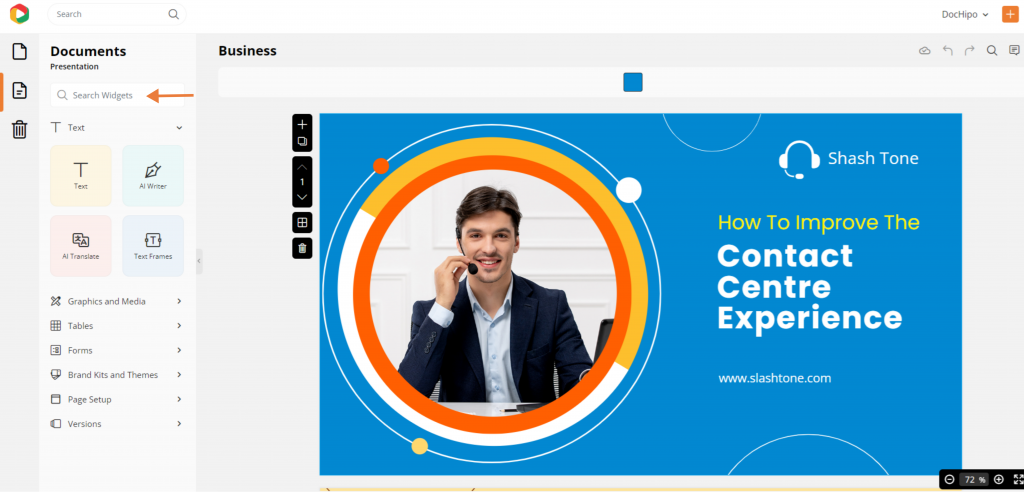
Quickly discover how to find design widgets in the editor.
A. Personalize the Text on Your Business Slides
Start by selecting the text on the slide that you want to update. Replace it with your own content to make it relevant to your message. Next, head to the editing bar at the top of the canvas, choose the font option, and pick a style that aligns with your brand or presentation theme.
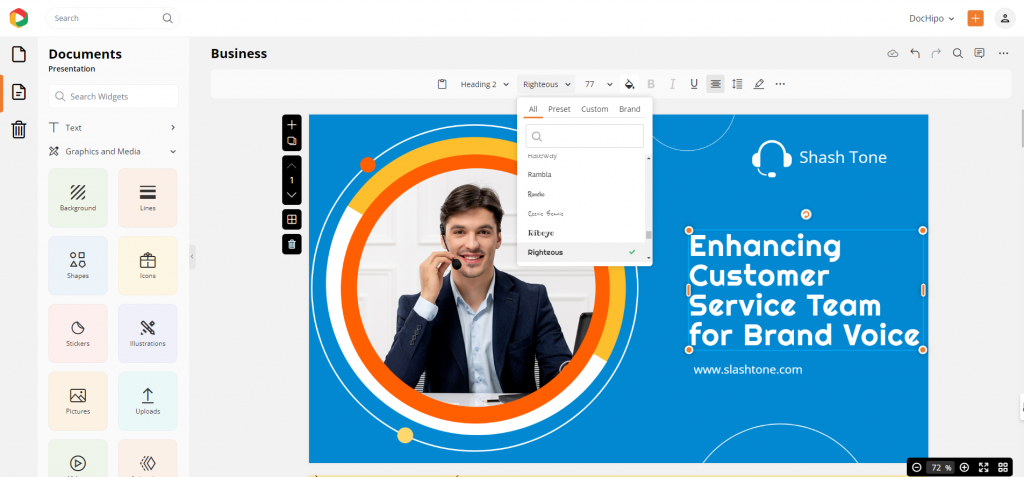
Watch this video to learn more about customizing text in the DocHipo editor.
Additionally, you can incorporate custom and branded fonts to give your design a personalized touch.
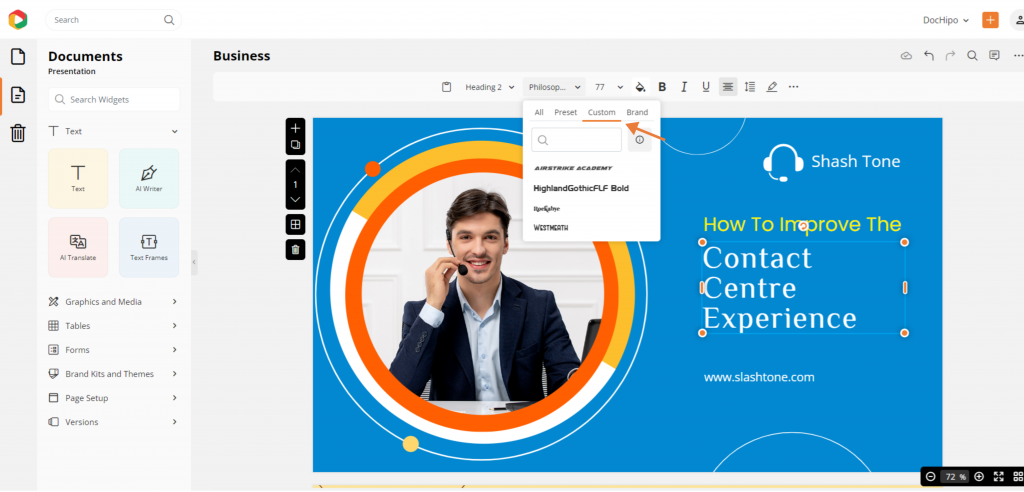
Check out this video to discover how to upload fonts in DocHipo.
You see, editing text is easy with the customizable features. But if you’re stressing about what to write in your slides, DocHipo’s AI capabilities can boost your process of creating a business presentation like a wordsmith. You can try DocHipo’s AI writer tool to create cool copies like the one in the following image.
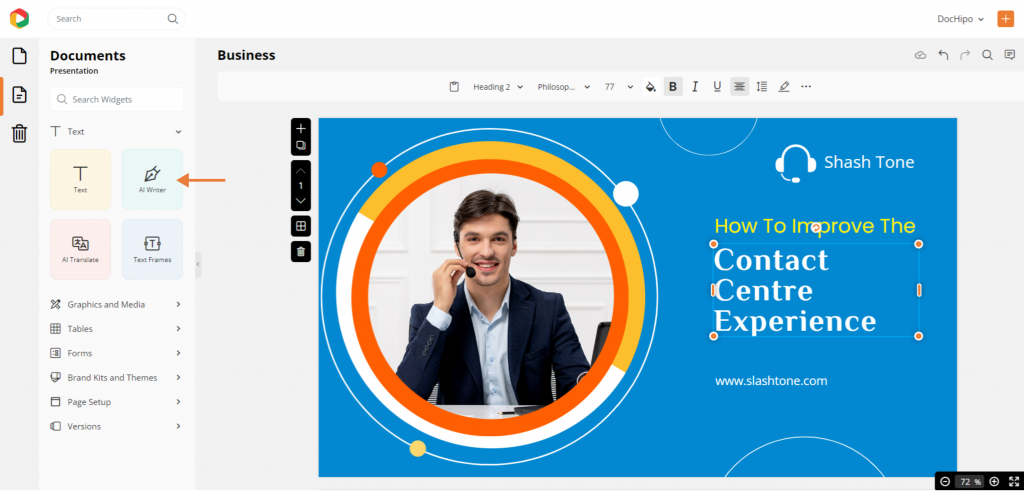
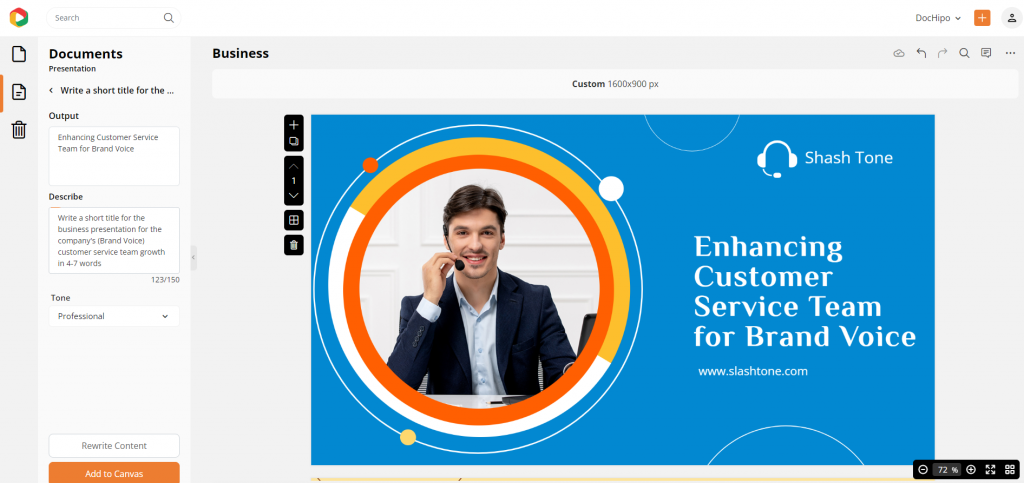
Watch the short video to try the AI writer tool in DocHipo.
B. Personalize Your Slide Images
Next, let’s update the title slide image to fit your presentation. You can either upload your own images or pick one that works best from the stock photo library. To do this, click the ‘Graphics and Media’ tab, then select the ‘Pictures’ option. From here, you can browse and choose the perfect image that enhances your slides.
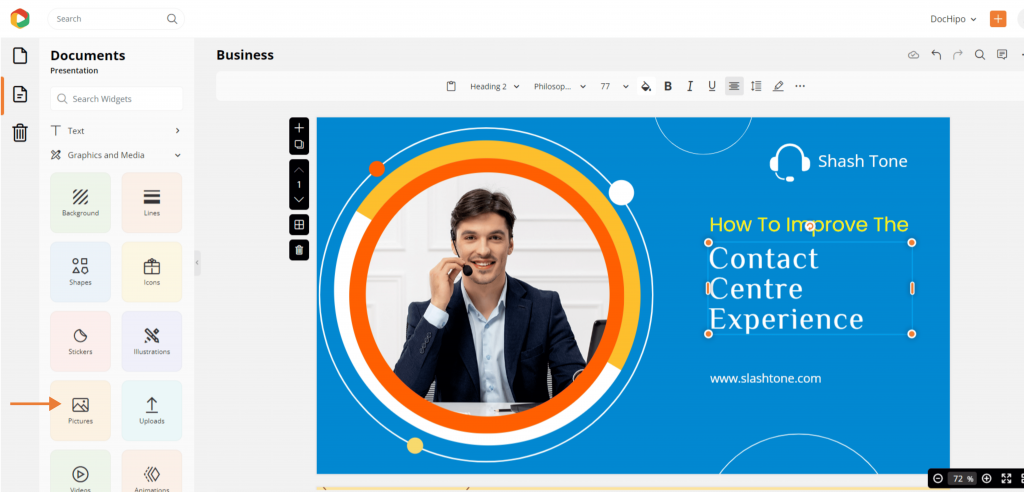
You’ll find a library of stock images available. To replace the current image in your design, simply search for the desired image and drag and drop it from the stock library into your design.
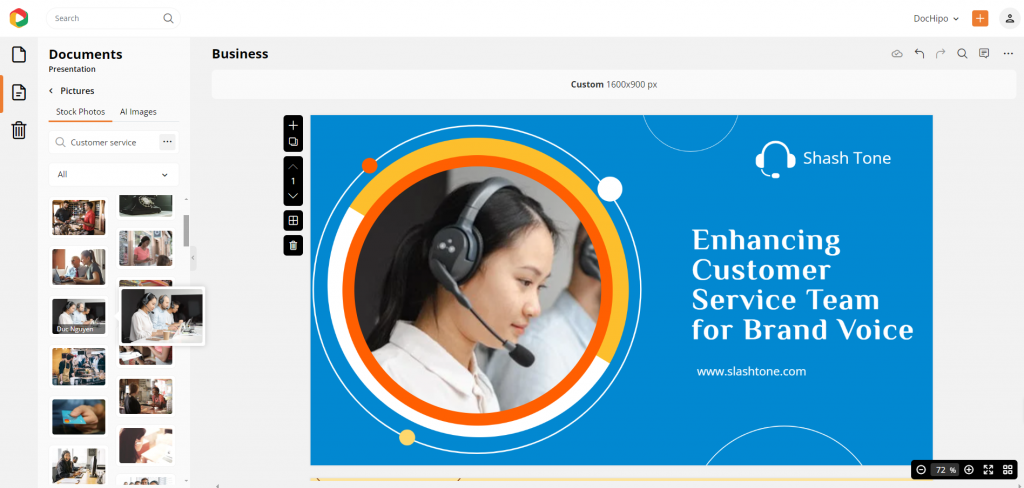
You can also upload your own image files in DocHipo.
Explore the extensive integration of DocHipo with the stock photo library.
C. Personalize Your Presentation Colors
Once you’ve added your images, you can enhance the overall look by customizing the colors of your design elements. Click on any element within your canvas, then pick a fitting color from the editing toolbar to match your presentation’s theme.
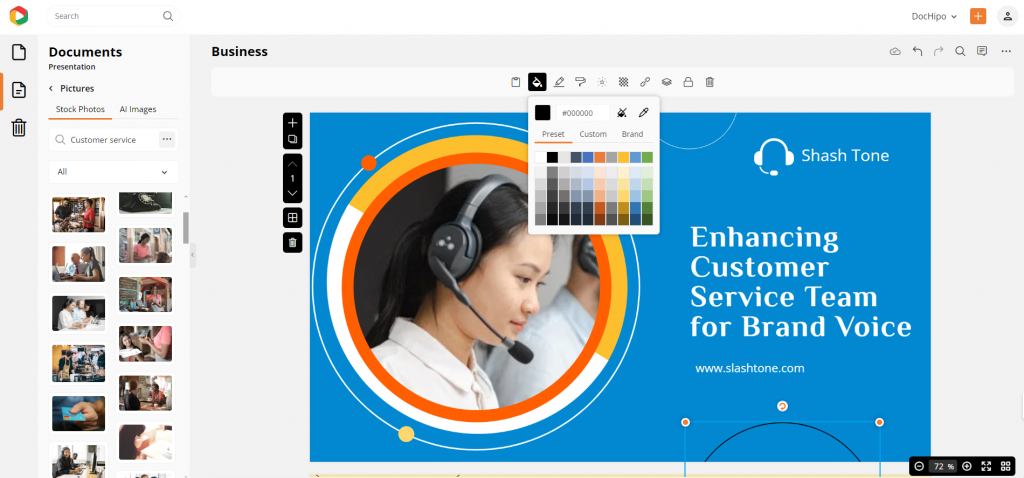
Selecting the right color palette can feel overwhelming, but there’s no need to stress! DocHipo simplifies the process by providing a range of preset colors within various themes. Just head over to the Themes section in the editor, and you’ll find plenty of options to choose from based on filters like occasions, moods, seasons, and more.
It’s that easy to find the perfect color theme for your business presentation background and slides! I’ve chosen the beautiful pastel theme for the presentation, and that’s how it turned out.
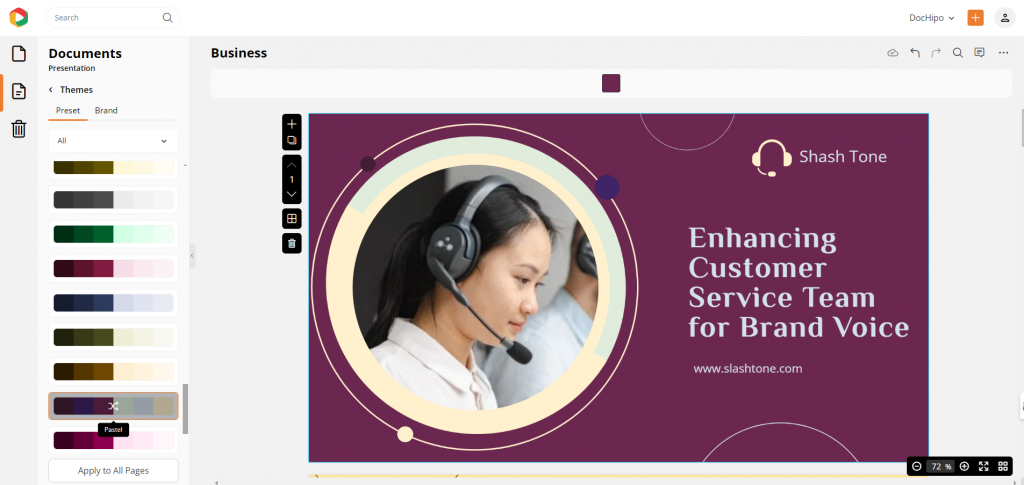
If you click on the “apply to all pages” option, you can change the color theme of each and every slide with one tap.
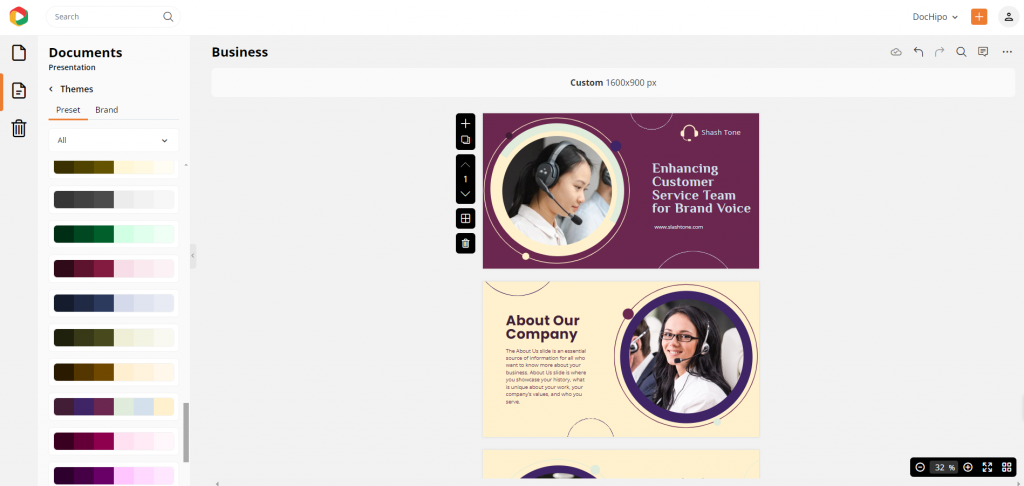
Watch this video to apply color themes to your design.
D. Enhance Your Slides with Graphic Elements
Ace in your business presentation by incorporating eye-catching graphic elements from DocHipo! With a treasure trove of design assets at your fingertips—think vibrant business icons, creative office and work illustrations, and lively animations resonating with product highlights and employee emotions—you can transform your slides into a captivating visual experience. These elements not only make your presentation more engaging but also help convey your message in a fun and memorable way.
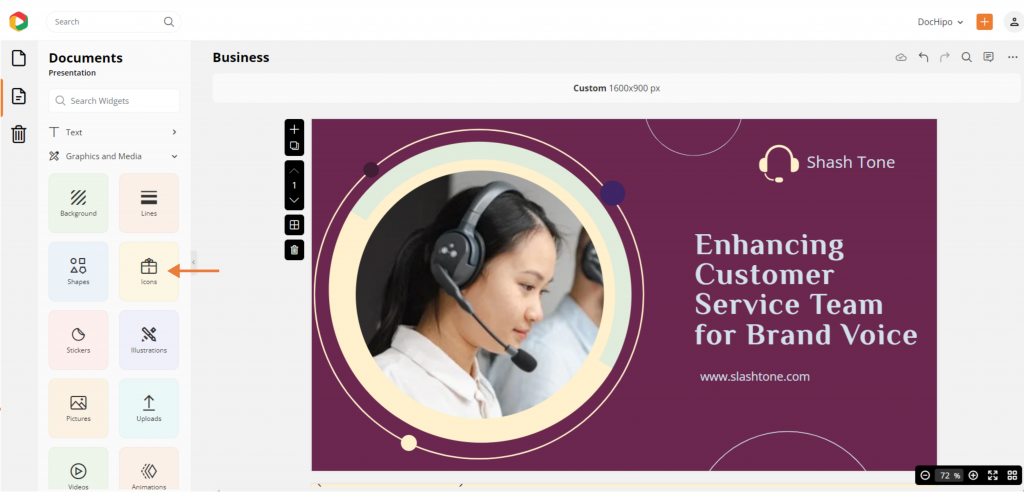
Check out the business-themed icons featured in this image! Feel free to customize them by adjusting their size, changing the colors, or even adding some animation to make them fit perfectly with your slide design.
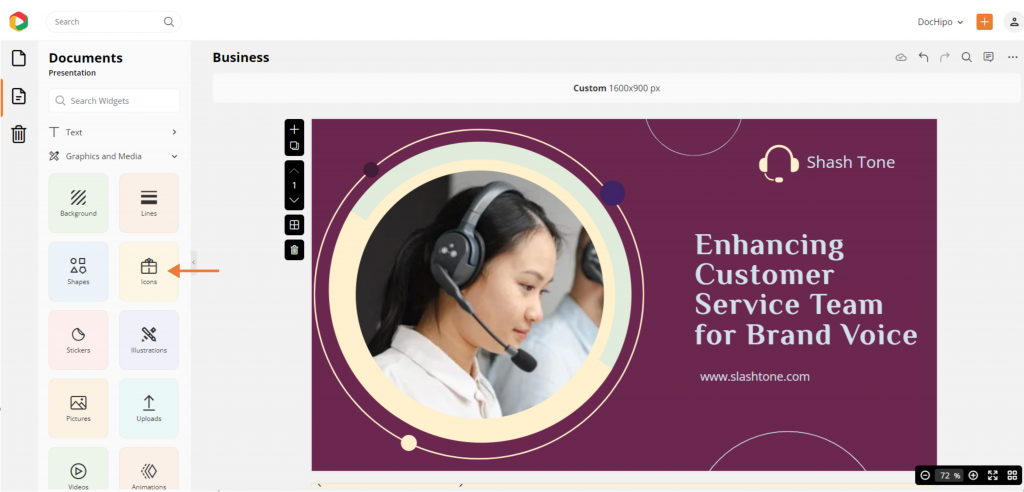
Watch this video to use various SGV assets in your business presentation.
E. Apply Transitions
Once you’ve nailed down all your customizations, it’s time to bring your presentation to life with some trendy page transitions! Just head over to the page setup option in DocHipo, and you’ll be ready to add those finishing touches that keep your audience engaged and excited.
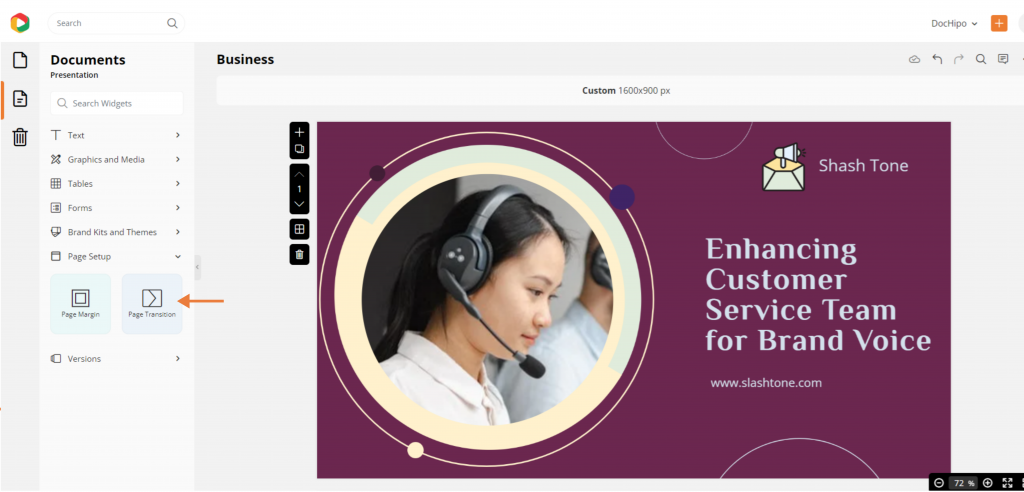
You can easily jazz up your slides by adding transitions like zoom, puff, slide, roll, flip, bounce, and even back! You also get to control how fast or slow they play, giving you full creative control. Want a consistent look? Apply the same transition across all your slides. Want to give it a mix of effects? Mix it up with different transitions on each one to keep your audience engaged and entertained!
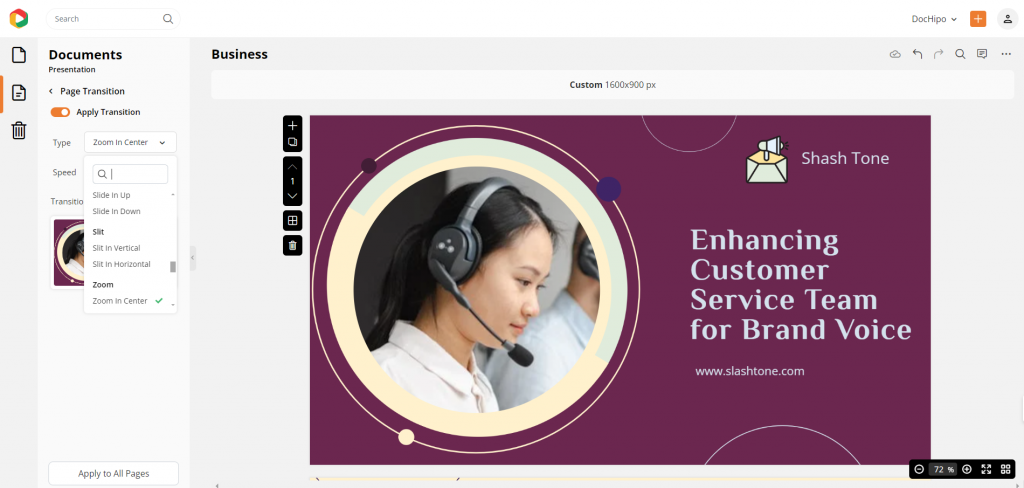
Try applying different page transitions with this video.
3. Download or Present Your Business Presentation
Once you’ve created your business slides and they look exactly the way you want, it’s time to download them in the perfect format—or better yet, present them directly from DocHipo! It’s quick, easy, and hassle-free, so you can confidently share your work without missing a beat.
Download in any format, i.e., PDF, MP4, JPEG, PNG, and more!
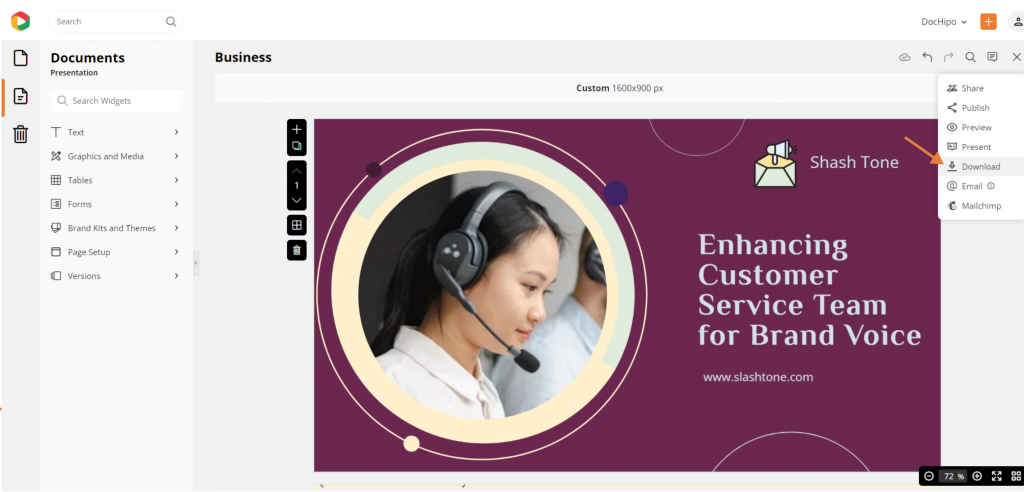
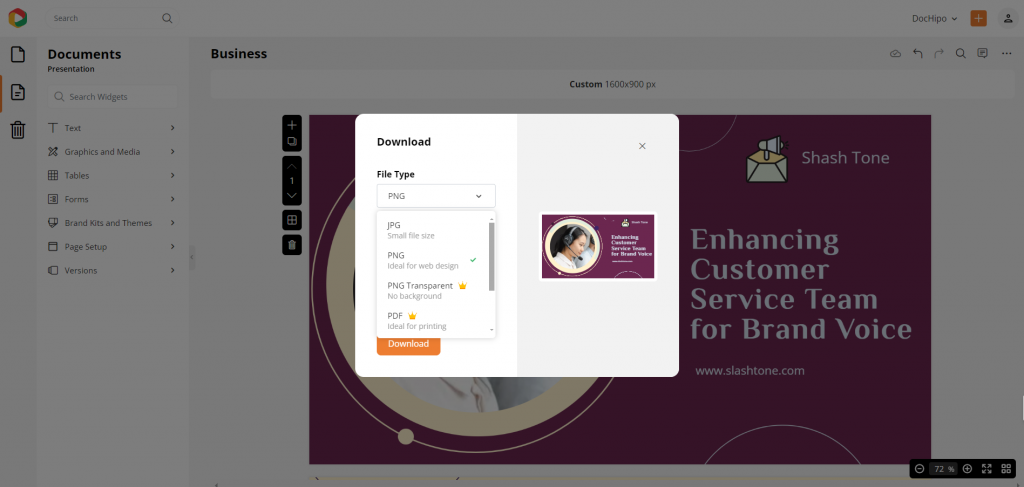
Explore the page-wise download option in DocHipo.
Also, click on ‘Present’ to enter Presenter mode, where you’ll get the power to highlight slides using a handy pointer. Plus, you can effortlessly view and navigate all the pages at once, making your presentation smooth and seamless!
So, what are you waiting for? Get started with DocHipo that shares advanced AI features and intuitive UI for every kind of content creator and marketer.
Conclusion
I hope all the tips, steps, and design ideas in this guide have given you the confidence to create a business presentation in no time! My goal here was to address the common challenges you might face and help you feel like a presentation pro in front of your audience. And let’s be honest—while all these tips are important, DocHipo’s AI-powered tools make the whole process way easier, even if you’re a total beginner.
So, if you’re looking to save time and effort, why not give DocHipo a try? With stunning templates, eye-catching visuals, and data-driven designs, you can quickly craft a presentation that wows your audience. Sign up with DocHipo today and start designing your next business presentation with minimal hassle!
FAQ
How to start a small business presentation?
Start by grabbing your audience’s attention with a compelling fact, a question, or a personal story. Clearly state the objective and what they can expect to learn. If you’re looking for a quick way to design an impressive opener, DocHipo’s ready-to-use templates with AI writer and AI text-to-image can help you create a professional, engaging introduction in minutes!
How to make a good presentation without PowerPoint?
You don’t need PowerPoint to create an amazing presentation! With DocHipo, you can use beautiful, business-ready templates and drag-and-drop tools to build your presentation online. It offers everything from dynamic layouts to stunning visuals and AI capabilities, helping you craft a sleek presentation without any hassle.
How to make a business presentation interactive?
To make your business presentation interactive, including polls, ask questions, and incorporate visual elements like infographics, maps, and data visualizations. With DocHipo, you can easily add engaging visuals that spark audience participation and keep them hooked throughout your presentation.
What is the main purpose for a business presentation?
The main purpose of a business presentation is to communicate information clearly and persuasively, whether it’s to pitch an idea, explain a strategy, or provide a solution.
How to make a business presentation fun?
Add humor, engaging visuals, or storytelling elements to make your presentation more enjoyable. DocHipo offers fun, customizable templates with vibrant visuals like marketing illustrations, beautiful stickers, creative business icons, text frames, and exciting animations that let you mix professionalism with uniqueness, making your presentation not only informative but entertaining, too!
What should a business presentation look like?
A business presentation should be clean, well-organized, and visually appealing, with a consistent design that aligns with your brand. DocHipo provides business-appropriate templates that maintain professionalism while allowing for creativity, ensuring your presentation looks polished and impactful.
How to make a business presentation in 7 easy steps?
To create an effective business presentation, start by defining your objective and understanding your target audience. Next, research and gather relevant information while anticipating potential questions your audience may have. Craft a clear outline to organize your content, keeping slide copies short and impactful. Finally, ensure your presentation maintains a cohesive design style.


